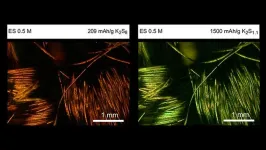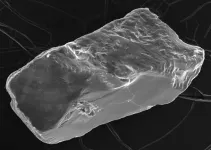(Press-News.org) In IVF treatment, embryos are traditionally transferred in the uterus three days after fertilization. Due to improvements in laboratory techniques, this is now also possible after five days. It was assumed that this increases the chance of a successful pregnancy. A study by Radboud university medical center and Amsterdam UMC shows that the day of transfer does not influence the success rate of the IVF trajectory.
One out of thirty children in the Netherlands is conceived via in vitro fertilization, or IVF for short. In this procedure, egg cells are fertilized outside the body and grown in the laboratory for several days. One or more embryos are then transferred back in the uterus and the rest is frozen. Traditionally, the laboratory phase lasts three days. Due to technical improvements, embryo transfer is now also possible after five days. The idea is that only viable embryos remain after five days, which increases the chance of a successful pregnancy. However, this leaves fewer embryos in the freezer.
Previous research has shown that the chance of success after the first transfer is indeed higher when this takes place on day five than on day three. But these studies did not evaluate the results of the entire IVF trajectory, including any subsequent transfer of frozen embryos. Research by Radboud university medical center, carried out in collaboration with Amsterdam UMC, changes this.
The same number of pregnancies
The study was conducted in 21 Dutch IVF centers among more than 1,200 women. At least four embryos had to be available for transfer two days after fertilization. In half of the women, embryos were transferred on day three, in the other half on day five. The outcome was the chance of a successful pregnancy during the entire IVF trajectory. This turned out to be the same in both groups, around sixty percent.
Researcher Simone Cornelisse explains the results: ‘Ultimately, IVF is about a successful pregnancy, and not only about the chances of success after the first transfer. Abroad, where IVF care is not insured, clinics often advertise their success rates from the first transfer on day five. In doing so, they provide an incomplete representation of the situation. Our study shows that women should have a choice about the moment of transfer.’
Personal decision
Other results from the study may influence that choice. As in previous research, there was a higher chance of a successful pregnancy after the first transfer on day five. There were also fewer miscarriages in that group. On the other hand, if the embryos were transferred on day three, more could be frozen for later use and the risk of premature birth was somewhat lower. Both choices have advantages and disadvantages, but do not make any difference to the overall success rate.
‘It is a very personal decision’, says clinical embryologist Liliana Ramos, one of the study leaders. ‘For some people, getting pregnant as quickly as possible is very important, for example if the woman is older. Someone else attaches more value to a larger number of frozen embryos or wants to keep the chance of premature birth as small as possible. There is no guideline regarding the day of transfer. Therefore, a couple who want to become pregnant must discuss it with the doctor and make a choice together.’
About the publication
This study was published in the British Medical Journal: Cumulative live birth rate of a blastocyst versus cleavage stage embryo transfer policy during in vitro fertilisation in women with a good prognosis: multicentre randomised controlled trial. S. Cornelisse, K. Fleischer, L. van der Westerlaken, J.P. de Bruin, C. Vergouw, C. Koks, J. Derhaag, J. Visser, J. van Echten-Arends, E. Slappendel, B. Arends, M. van der Zanden, A. van Dongen, J. Brink-van der Vlugt, M. de Hundt, M. Curfs, H. Verhoeve, M. Traas-Hofmans, Y. Wurth, P. Manger, Q. Pieterse, D. Braat, M. van Wely, L. Ramos, S. Mastenbroek.
END
Chances of successful pregnancy are the same with embryo transfer on day three or five
'Make a choice together with the doctor about the moment of transfer in IVF treatment'
2024-09-16
ELSE PRESS RELEASES FROM THIS DATE:
The Lancet: More than 39 million deaths from antibiotic-resistant infections estimated between now and 2050, suggests first global analysis
2024-09-16
Embargoed access to the paper and contact details for authors are available in Notes to Editors at the end of the release.
The Lancet: More than 39 million deaths from antibiotic-resistant infections estimated between now and 2050, suggests first global analysis
First in-depth analysis of global health impacts of antimicrobial resistance (AMR) over time reveals trends from 1990 to 2021 and estimates potential impacts to 2050 for 204 countries and territories.
More than one million people died from AMR globally each year between 1990 and 2021. Over the period, AMR deaths among children aged under five declined by 50% while those among people aged 70 ...
Fraunhofer IAF low-noise amplifiers aboard the Arctic Weather Satellite
2024-09-16
The Arctic Weather Satellite (AWS) of the European Space Agency (ESA) was sent on its journey to a polar orbit 600 km above the Earth on August 16, 2024. On board: four low-noise amplifiers (LNAs) from the Fraunhofer Institute for Applied Solid State Physics IAF in Freiburg. They are essential components of the passive microwave radiometer with which the AWS measures temperature and humidity in the Arctic more precisely than ever before. This should contribute to a better understanding of both the Arctic and the climate change that is particularly visible in it. If the mission is successful, ...
Immunotherapy after surgery helps people with high-risk bladder cancer live cancer-free longer
2024-09-16
Results from a large clinical trial show that treatment with an immunotherapy drug may nearly double the length of time people with high-risk, muscle-invasive bladder cancer are cancer-free following surgical removal of the bladder. Researchers found that postsurgical treatment with pembrolizumab (Keytruda), which is approved by the Food and Drug Administration (FDA) for treating at least 18 different cancers, was superior compared with observation. The study, led by researchers at the National Institutes of Health (NIH), ...
US COVID-19 rates oscillate every six months
2024-09-16
COVID-19 cases in the U.S. have shown unexpected oscillating waves every six months between the southern states and the northern states and, to a lesser degree, from east to west, according to new research published today in Scientific Reports.
Public health scientists from the University of Pittsburgh, University of Ottawa and University of Washington conducted the first detailed analysis to demonstrate and characterize the six-month oscillation of cases across space and time. It provides key information ...
Lower neighborhood opportunity may increase risk for preterm birth
2024-09-16
FOR IMMEDIATE RELEASE
Monday, September 16, 2024
Contact:
Jillian McKoy, jpmckoy@bu.edu
Michael Saunders, msaunder@bu.edu
##
Lower Neighborhood Opportunity May Increase Risk for Preterm Birth
A new study suggests that neighborhoods with fewer educational, health, environmental, and socioeconomic resources may increase one’s risk for preterm birth and contribute to the racial gap in preterm birth in the Commonwealth.
Preterm birth, defined as a live birth before 37 weeks of pregnancy, is the second-leading cause of infant mortality in the United States, and one that disproportionately affects Black and ...
Analysis finds cardiac devices recalled for safety reasons infrequently subjected to premarket or postmarket testing
2024-09-16
Embargoed for release until 5:00 p.m. ET on Monday 16 September 2024
@Annalsofim
Below please find summaries of new articles that will be published in the next issue of Annals of Internal Medicine. The summaries are not intended to substitute for the full articles as a source of information. This information is under strict embargo and by taking it into possession, media representatives are committing to the terms of the embargo not only on their own behalf, but also on behalf of the organization they represent.
----------------------------
1. ...
Trailblazers in plasma turbulence computer simulations win 2024 James Clerk Maxwell Prize
2024-09-16
A pair of physicists with long ties to PPPL are being honored for their foundational work on turbulence in plasma. Understanding why instabilities occur and how to limit them is critical to perfecting fusion as a stable energy source for the electrical grid.
Greg Hammett, a PPPL theoretical and computational principal research physicist, and Bill Dorland, former associate laboratory director for computational sciences and current Lab adviser, have won the 2024 James Clerk Maxwell Prize for Plasma Physics. The American ...
Technology could boost renewable energy storage
2024-09-16
Renewable energy sources like wind and solar are critical to sustaining our planet, but they come with a big challenge: they don't always generate power when it's needed. To make the most of them, we need efficient and affordable ways to store the energy they produce, so we have power even when the wind isn't blowing or the sun isn't shining.
Columbia Engineering material scientists have been focused on developing new kinds of batteries to transform how we store renewable energy. In a new study published September 5 by Nature Communications, the team used K-Na/S batteries that combine inexpensive, readily-found elements -- ...
Introducing SandAI: A tool for scanning sand grains that opens windows into recent time and the deep past
2024-09-16
Stanford researchers have developed an artificial intelligence-based tool – dubbed SandAI – that can reveal the history of quartz sand grains going back hundreds of millions of years. With SandAI, researchers can tell with high accuracy if wind, rivers, waves, or glacial movements shaped and deposited motes of sand.
The tool gives researchers a unique window into the past for geological and archeological studies, especially for eras and environments where few other clues, such as fossils, are preserved ...
Critical crops’ alternative way to succeed in heat and drought
2024-09-16
Scientists have discovered that certain plants can survive stressful, dry conditions by controlling water loss through their leaves without relying on their usual mechanism - tiny pores known as ‘stomata’.
Nonstomatal control of transpiration in maize, sorghum, and proso millet – all C4 crops which are critical for global food security – gives these plants an advantage in maintaining a beneficial microclimate for photosynthesis within their leaves.
This allows the plants to absorb carbon dioxide ...
LAST 30 PRESS RELEASES:
UVA’s Jundong Li wins ICDM’S 2025 Tao Li Award for data mining, machine learning
UVA’s low-power, high-performance computer power player Mircea Stan earns National Academy of Inventors fellowship
Not playing by the rules: USU researcher explores filamentous algae dynamics in rivers
Do our body clocks influence our risk of dementia?
Anthropologists offer new evidence of bipedalism in long-debated fossil discovery
Safer receipt paper from wood
Dosage-sensitive genes suggest no whole-genome duplications in ancestral angiosperm
First ancient human herpesvirus genomes document their deep history with humans
Why Some Bacteria Survive Antibiotics and How to Stop Them - New study reveals that bacteria can survive antibiotic treatment through two fundamentally different “shutdown modes”
UCLA study links scar healing to dangerous placenta condition
CHANGE-seq-BE finds off-target changes in the genome from base editors
The Journal of Nuclear Medicine Ahead-of-Print Tip Sheet: January 2, 2026
Delayed or absent first dose of measles, mumps, and rubella vaccination
Trends in US preterm birth rates by household income and race and ethnicity
Study identifies potential biomarker linked to progression and brain inflammation in multiple sclerosis
Many mothers in Norway do not show up for postnatal check-ups
Researchers want to find out why quick clay is so unstable
Superradiant spins show teamwork at the quantum scale
Cleveland Clinic Research links tumor bacteria to immunotherapy resistance in head and neck cancer
First Editorial of 2026: Resisting AI slop
Joint ground- and space-based observations reveal Saturn-mass rogue planet
Inheritable genetic variant offers protection against blood cancer risk and progression
Pigs settled Pacific islands alongside early human voyagers
A Coral reef’s daily pulse reshapes microbes in surrounding waters
EAST Tokamak experiments exceed plasma density limit, offering new approach to fusion ignition
Groundbreaking discovery reveals Africa’s oldest cremation pyre and complex ritual practices
First breathing ‘lung-on-chip’ developed using genetically identical cells
How people moved pigs across the Pacific
Interaction of climate change and human activity and its impact on plant diversity in Qinghai-Tibet plateau
From addressing uncertainty to national strategy: an interpretation of Professor Lim Siong Guan’s views
[Press-News.org] Chances of successful pregnancy are the same with embryo transfer on day three or five'Make a choice together with the doctor about the moment of transfer in IVF treatment'



